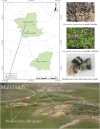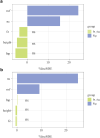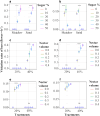Plant reproductive strategies and pollinator attributes differ in small-scale habitat heterogeneity
- PMID: 41036205
- PMCID: PMC12480739
- DOI: 10.1093/aobpla/plaf052
Plant reproductive strategies and pollinator attributes differ in small-scale habitat heterogeneity
Abstract
Habitat variability critically influences plant reproductive strategies and pollinator attributes. However, studies on intraspecific variation in vegetative and floral traits, pollinator attributes, and seed traits remain limited in the context of small-scale habitat heterogeneity, particularly meadows interspersed with sandy patches. On the Tibetan Plateau, discrete sandy patches (some as small as 10 m2) occur within alpine meadows. We hypothesized that distinct plant reproductive strategies and pollinator attributes exist between meadows and sandy habitats at a microhabitat scale. To test this hypothesis, we conducted a field experiment to investigate variation in floral traits, pollinator attributes, and seed traits in a Tibetan alpine herb (Astragalus purpurinus) across meadow and sandy habitats. Our results show that meadow populations produced fewer nectar-enriched flowers with high sugar concentrations, fewer and larger seeds, and were pollinated primarily by bumble bees. In contrast, sandy-habitat populations produced numerous nectar-poor flowers with low sugar concentrations, more numerous small seeds, and relied on mason bees for pollination. Our results demonstrate that micro-scale habitat heterogeneity drives divergent plant reproductive strategies and pollinator attributes within a single species. These findings reveal novel mechanisms by which small-scale environmental variation shapes reproductive adaptation in alpine ecosystems.
Keywords: alpine meadow; bee behavior; land restoration; pollination; reproductive strategies.
© The Author(s) 2025. Published by Oxford University Press on behalf of the Annals of Botany Company.
Conflict of interest statement
Conflict of interest: None declared.
Figures







References
-
- Ahrenfeldt EJ, Sigsgaard L, Hansted L et al. Forage quality and quantity affect red mason bees and honeybees differently in flowers of strawberry varieties. Entomol Exp Appl 2019;167:763–73. 10.1111/eea.12820 - DOI
-
- Aizen MA, Vazquez DP. Flower performance in human-altered habitats. In: Harder LD, Barrett SCH (eds.) Ecology and Evolution of Flowers. Oxford, UK: Oxford University Press, 2006, 159–79.
-
- Allen-Perkins A, Artamendi M, Montoya D et al. Untangling the plant reproductive success of changing community composition and pollinator foraging choices. Ecography 2025;2025:e07240. 10.1111/ecog.07240 - DOI
-
- Arroyo MTK, Armesto JJ, Primack RB. Community studies in pollination ecology in the high temperate Andes of central Chile II. Effect of temperature on visitation rates and pollination possibilities. Pl Syst Evol 1985;149:187–203. 10.1007/BF00983305 - DOI
LinkOut - more resources
Full Text Sources

